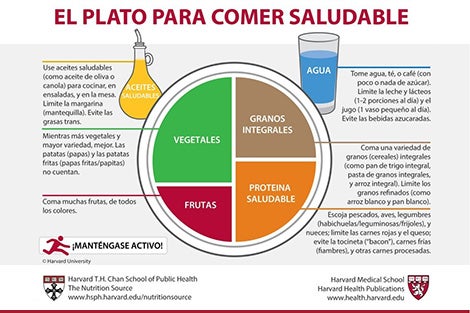For immediate release: April 27, 2015
Boston, MA ─ The Healthy Eating Plate—a simple, visual meal-planning guide that addresses important deficiencies in the U.S. government’s MyPlate icon—has now been translated into 14 new languages by its developers at the Harvard T.H. Chan School of Public Health, giving it the potential to reach over half the world’s population.
Like the U.S. government’s MyPlate, the Healthy Eating Plate is easy to understand—but unlike the government’s icon, it provides clear guidance on such topics as the importance of eating more whole grains and avoiding refined grains, and distinguishing between healthy proteins and those that should be limited or avoided.
The sections of the Healthy Eating Plate include vegetables and fruits, healthy proteins (fish, poultry, beans, and nuts), whole grains, healthy oils, and water. It advises individuals to limit consumption of refined grains such as white bread and white rice, red meat, and dairy, and to avoid processed meats, trans fats, and sugary drinks.
“We have been ahead of the curve in translating nutrition science into practical recommendations,” said Lilian Cheung, lecturer in the Department of Nutrition. The new federal nutrition recommendations from the 2015 Dietary Guidelines Advisory Committee are moving in the direction of the blueprint established by the Healthy Eating Plate when it was launched in 2011.
People around the world are eager for this practical information, Cheung said, but many countries lack their own dietary guidelines based on the latest science. The Department of Nutrition hopes the new translations of the Plate will help more people worldwide choose a healthy diet.
New translations of the Healthy Eating Plate are now available on The Nutrition Source website in the following languages and can be found here:
- Arabic (Standard)
- Bosnian
- Chinese (Mandarin Simplified)
- Chinese (Mandarin Traditional)
- Croatian
- Dutch
- Farsi (Persian)
- French (Canadian)
- Hausa
- Japanese
- Korean
- Portuguese
- Serbian
- Spanish (General)
- Spanish (Spain)
- Swedish
Launched in 2011 in conjunction with Harvard Health Publications, the Healthy Eating Plate is based on the latest and best scientific evidence, which shows that a primarily plant-based diet rich in vegetables, whole grains, healthy fats, and healthy proteins lowers the risk of weight gain and chronic diseases. Helping people everywhere get the best possible nutritional advice is of critical importance because an unhealthy diet is a major cause of chronic diseases and the world faces a burgeoning epidemic of obesity, diabetes, cardiovascular disease, and cancer.
Visit the Harvard Chan website for the latest news, press releases, and multimedia offerings.
For more information:
Todd Datz
tdatz@hsph.harvard.edu
617-432-8413
###
Harvard T.H. Chan School of Public Health brings together dedicated experts from many disciplines to educate new generations of global health leaders and produce powerful ideas that improve the lives and health of people everywhere. As a community of leading scientists, educators, and students, we work together to take innovative ideas from the laboratory to people’s lives—not only making scientific breakthroughs, but also working to change individual behaviors, public policies, and health care practices. Each year, more than 400 faculty members at Harvard Chan teach 1,000-plus full-time students from around the world and train thousands more through online and executive education courses. Founded in 1913 as the Harvard-MIT School of Health Officers, the School is recognized as America’s oldest professional training program in public health.
